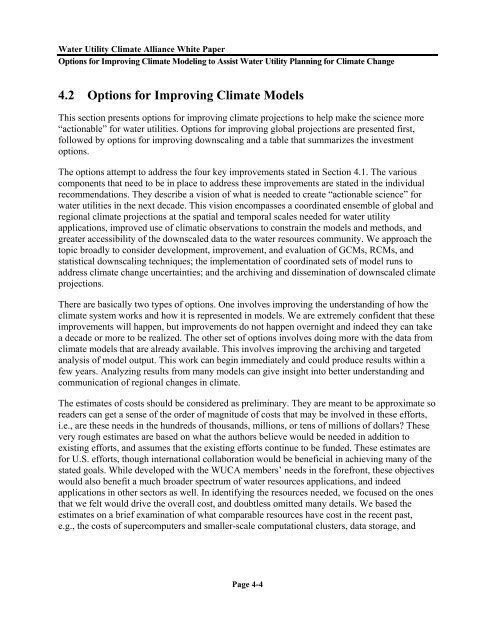Options for Improving Climate Modeling to Assist Water Utility ...
Options for Improving Climate Modeling to Assist Water Utility ...
Options for Improving Climate Modeling to Assist Water Utility ...
You also want an ePaper? Increase the reach of your titles
YUMPU automatically turns print PDFs into web optimized ePapers that Google loves.
<strong>Water</strong> <strong>Utility</strong> <strong>Climate</strong> Alliance White Paper<br />
<strong>Options</strong> <strong>for</strong> <strong>Improving</strong> <strong>Climate</strong> <strong>Modeling</strong> <strong>to</strong> <strong>Assist</strong> <strong>Water</strong> <strong>Utility</strong> Planning <strong>for</strong> <strong>Climate</strong> Change<br />
4.2 <strong>Options</strong> <strong>for</strong> <strong>Improving</strong> <strong>Climate</strong> Models<br />
This section presents options <strong>for</strong> improving climate projections <strong>to</strong> help make the science more<br />
“actionable” <strong>for</strong> water utilities. <strong>Options</strong> <strong>for</strong> improving global projections are presented first,<br />
followed by options <strong>for</strong> improving downscaling and a table that summarizes the investment<br />
options.<br />
The options attempt <strong>to</strong> address the four key improvements stated in Section 4.1. The various<br />
components that need <strong>to</strong> be in place <strong>to</strong> address these improvements are stated in the individual<br />
recommendations. They describe a vision of what is needed <strong>to</strong> create “actionable science” <strong>for</strong><br />
water utilities in the next decade. This vision encompasses a coordinated ensemble of global and<br />
regional climate projections at the spatial and temporal scales needed <strong>for</strong> water utility<br />
applications, improved use of climatic observations <strong>to</strong> constrain the models and methods, and<br />
greater accessibility of the downscaled data <strong>to</strong> the water resources community. We approach the<br />
<strong>to</strong>pic broadly <strong>to</strong> consider development, improvement, and evaluation of GCMs, RCMs, and<br />
statistical downscaling techniques; the implementation of coordinated sets of model runs <strong>to</strong><br />
address climate change uncertainties; and the archiving and dissemination of downscaled climate<br />
projections.<br />
There are basically two types of options. One involves improving the understanding of how the<br />
climate system works and how it is represented in models. We are extremely confident that these<br />
improvements will happen, but improvements do not happen overnight and indeed they can take<br />
a decade or more <strong>to</strong> be realized. The other set of options involves doing more with the data from<br />
climate models that are already available. This involves improving the archiving and targeted<br />
analysis of model output. This work can begin immediately and could produce results within a<br />
few years. Analyzing results from many models can give insight in<strong>to</strong> better understanding and<br />
communication of regional changes in climate.<br />
The estimates of costs should be considered as preliminary. They are meant <strong>to</strong> be approximate so<br />
readers can get a sense of the order of magnitude of costs that may be involved in these ef<strong>for</strong>ts,<br />
i.e., are these needs in the hundreds of thousands, millions, or tens of millions of dollars? These<br />
very rough estimates are based on what the authors believe would be needed in addition <strong>to</strong><br />
existing ef<strong>for</strong>ts, and assumes that the existing ef<strong>for</strong>ts continue <strong>to</strong> be funded. These estimates are<br />
<strong>for</strong> U.S. ef<strong>for</strong>ts, though international collaboration would be beneficial in achieving many of the<br />
stated goals. While developed with the WUCA members’ needs in the <strong>for</strong>efront, these objectives<br />
would also benefit a much broader spectrum of water resources applications, and indeed<br />
applications in other sec<strong>to</strong>rs as well. In identifying the resources needed, we focused on the ones<br />
that we felt would drive the overall cost, and doubtless omitted many details. We based the<br />
estimates on a brief examination of what comparable resources have cost in the recent past,<br />
e.g., the costs of supercomputers and smaller-scale computational clusters, data s<strong>to</strong>rage, and<br />
Page 4-4

















